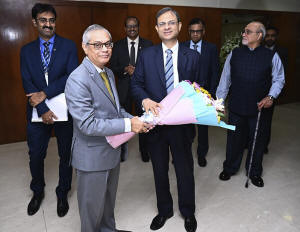India's new central bank governor takes over as economic growth slows
and inflation rises
 Send a link to a friend
Send a link to a friend
 [December 11, 2024] By
ASHOK SHARMA [December 11, 2024] By
ASHOK SHARMA
NEW DELHI (AP) — India got a new central bank governor on Wednesday as
the country’s economic growth slows and inflation surges.
Sanjay Malhotra, a career civil servant, was appointed to a three-year
term as head of the Reserve Bank of India, succeeding Shaktikanta Das,
who retired as central bank governor after an extended six-year term.
India’s economy grew at a 5.4% annual pace in the last quarter, the
weakest pace in nearly two years, while inflation rose to 6.2% in
October, well above the RBI’s target of 4%, due to rapid increases in
vegetable prices.
“Malhotra takes over at a time when there is a growing clamor for the
RBI to ease policy rates in order to support growth. His challenge will
be to steer the central bank through a period of global and domestic
uncertainty,” the Indian Express newspaper said in an editorial.
In a brief statement Wednesday, Malhotra, who used to be a revenue
secretary, said his focus would be on stability, quick implementation of
policies, and economic growth,
"Stable policies are very important, whether it’s taxation, fiscal, or
monetary policy," he said.
He also said remaining “alert and agile” to meet the changes the world
witnesses today, whether geopolitical tensions, the impact of climate
change or political uncertainty, was a must.
"People need continuity and stability rather than a day-to-day kind of
policy," he said.
Malhotra, 56, had earlier worked in India’s Ministry of Power and headed
a public sector company that provided finance for rural electrification
projects.
In his previous role as India’s revenue secretary, he was vocal about
tax overreach. Speaking at a federal event in New Delhi last week,
Malhora said that state officials had to work to improve the entire
economy and not simply get more revenue via taxation.
“Revenue comes in only when there is some income. Therefore, we have to
be very cautious so that we do not, as they say, kill the golden goose,”
he said.
[to top of second column] |

In this photo obtained from the Indian Reserve Bank of India, or RBI
page on X, formerly known as Twitter, shows new RBI Gov. Sanjay
Malhotra, center, is welcomed by his colleagues at an office in
Mumbai India Wednesday, Dec. 11, 2024. (Reserve Bank of India via
AP)
 Last Friday, the central bank under
Das left interest rates at 6.5%, unchanged since February last year,
as rising food prices pushed inflation higher. However, it reduced
the cash reserve ratio, which banks must hold to ease monetary
conditions and support growth, to 4% from 4.5%.
Economists expect inflationary pressures to subside in the coming
months, clearing the way for a rate cut in the spring.
“A slowdown in urban consumer spending is reigniting worries over
structural weaknesses in India’s economy, as high inflation along
with weak jobs and low wage growth hurt demand growth,” Shumita
Deveshwar of TS Lombard said in a recent report.
The Reserve Bank has revised its forecast for economic growth in the
April-March fiscal year to 6.6% from an earlier estimate of 7.2%.
The central bank said the decline was mainly the result of a
slowdown in mining and in some manufacturing industries, such as
petroleum products, iron and steel and cement.
It said it expected a recovery in industrial activity helped by
higher government spending following the lulls of the monsoon
season.
"Supply chain pressures eased in October-November and fell below the
historical average. The services sector continues to grow at a
strong pace,” it said.
—
Associated Press writer Aniruddha Ghosal from Hanoi, Vietnam
contributed to this report.
All contents © copyright 2024 Associated Press. All rights reserved |